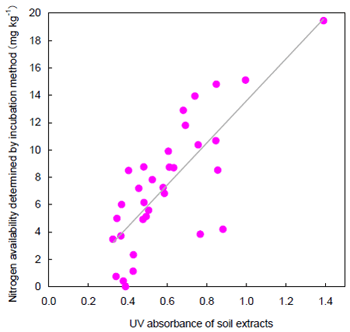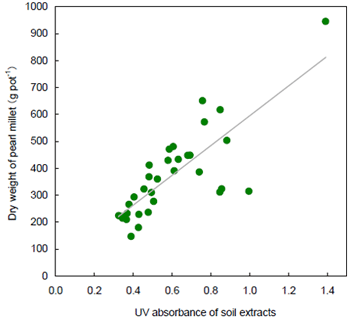Estimation of nitrogen availability in infertile sandy soils in the tropical areas using UV absorbance of soil extracts
Description
Nitrogen availability in soils is normally determined by the incubation method which measures inorganic nitrogen produced under the conditions that promote nitrogen mineralization from organic sources. This incubation method, however, requires several weeks to complete, and therefore, simpler chemical extraction methods have been developed for rapid determination.
One of the chemical extraction methods, which is proven in Japan, involves the extraction of soils with phosphate buffer solution and then determining the organic nitrogen content of the resulting soil extracts by measuring its UV absorbance at 280 nm. We applied this UV absorption method in the infertile sandy soils of West Africa, and examined the relationship between the UV absorbance of the soil extract and the dry matter of pearl millet, the main food of the people in the Sahelian region, grown in that soil.
Soil samples were collected from the soil surface layer (0-15 cm) in pearl millet fields in three villages in the Fakara region of Niger under various soil fertility managements such as no-input, corralling (confining livestock in the field), manure application, fallowing for 1 to 10 years, and reserved fallowing in which livestock are held off. The air-dried soil samples were treated with 0.067 M phosphate buffer (pH 7.0), and the absorbance of the soil extracts was measured at 280 nm with a spectrophotometer. To examine the nitrogen availability for crop growth, pearl millet was cultivated in pots containing 1 kg of the soil sample which was added with an adequate supply of water and nutrients, except nitrogen. The dry weight of the aboveground plant parts of pearl millet was measured at 28 days after sowing.
Our results show that there is a positive correlation (r = 0.77, P < 0.01) between inorganic nitrogen mineralized under incubation (nitrogen availability determined by the incubation method) and the absorbance of phosphate buffer soil extracts at 280 nm (Fig. 1). Nitrogen availability of the soils in this region can be estimated by the measurement of the UV absorbance of soil extract using this regression formula, which can be applied to the infertile soils with a total nitrogen content ranging from 0.07 to 0.61 g kg-1. Likewise, the UV absorbance of the soil extracts at 280 nm showed a positive correlation (r = 0.79, P < 0.01) with the dry weight of pearl millet at 28 days after sowing (Fig. 2). These results demonstrate that the UV absorbance of soil extracts can be used to estimate the nitrogen fertility of the soils.
Figure, table
-
Fig. 1.
Relationship between the nitrogen availability determined by incubation method and the UV absorbance of phosphate buffer soil extracts at 280 nm. -
Relationship between the dry weight of pearl millet at 28 days after sowing and the UV absorbance of phosphate buffer soil extracts at 280 nm. -
-
-
- Affiliation
-
Japan International Research Center for Agricultural Sciences Crop Production and Environment Division
-
University of Tokyo
- Classification
-
Technical A
- Term of research
-
FY2005~2007(FY2003~2005, FY2006~2010)
- Responsible researcher
-
SUZUKI Kanako ( University of Tokyo )
OKADA Kensuke ( University of Tokyo )
Hayashi Keiichi ( Crop, Livestock and Environment Division )
MATSUNAGA Ryoichi ( Crop Production and Environment Division )
MATSUMOTO Naruo ( Crop Production and Environment Division )
TOBITA Satoshi ( Crop Production and Environment Division )
- ほか
- Publication, etc.
-
Suzuki K, Matsunaga R, Hayashi K, Matsumoto N, Tobita S and Okada K. 2008. Applicability of phosphate buffer-extractable organic nitrogen as an indicator of available nitrogen in the sandy soils of the Sahel zone of Niger, West Africa. Soil Sci. Plant Nutr., 54: 449-458.
- Japanese PDF
-
2007_seikajouhou_A4_ja_Part12.pdf445.15 KB


